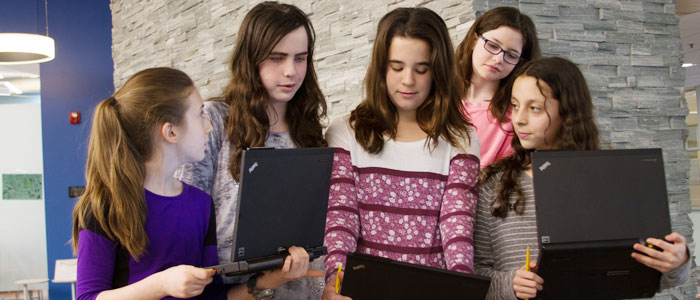Transforming Education
By Vivian Henoch, Editor myJewishDetroit
March 1, 2015
Jonah Weinbaum, an eighth grader at Hillel Day School, is glad he’s graduating this year, and not last year. “Last year, I could think about things I want to make, but this year, I have an idea one night and the next day at recess, I’m working on it.”
Jonah, a budding computer scientist with an interest in app development, is working out his ideas in Hillel’s new Innovation Hub and Maker Space, part of the new Audrey and William Farber Family IDEA Collaborative. The light-filled, flexibly-designed space was completed in September after a $5.3 million gift by the family facilitated the transformation of Hillel’s building. The new space now boasts 3D printing and laser cutting capabilities, green-screen technology in an audio/visual studio, a greenhouse, and new art, science and music rooms.
Breaking the mold, building a new model
With its emphasis on structure, form and organization, the sciences appeal to Jonah, and the Maker Space allows him to express his passion and intelligence through the application of the knowledge he learns in science teacher David Venning’s class. After a magnetics unit, for example, he began to research magnetic fields and ways to use the stored energy in his hand. Ultimately, he lined a cardboard box with aluminum to create a capacitor that bound to the stored energy in his own hand, and used a computer program to allow that energy to virtually move an object on a computer screen.
It’s all about imagining – and reimagining – the things you want to build, the problems you want to solve, the life you want to live – and figuring out how to do it.” Trevett Allen, Hillel Day School Director of Innovation
“My goal is to be able to use my hand virtually to play 3D tic-tac-toe, because a typical mouse on a keypad is less intuitive than your own hand,” Weinbaum explained.
The educational underpinnings of Hillel’s maker space are illustrated in Weinbaum’s refinement of his capacitor.
“It takes several iterations of a prototype to make a product, and it’s in the failing and the perseverance that our students really master, not only the concepts they are learning in school, but also the skills necessary to succeed in the 21st century,” said Trevett Allen, Hillel’s new Director of Innovation.
Allen, a specialist in technology integration in the classroom, also has a fine arts background. He supports Hillel’s faculty as they work to augment the general and Jewish studies curriculum with authentic, project-based learning.
“It’s kind of a hybrid model,” Allen explained. “As we rely less on textbook instruction, student-driven learning guided by teachers takes on more depth and becomes the norm.” In science, for example, a lesson on earthquakes becomes a real-life demonstration as students design structures using a software program called Sketch-Up, and then test their designs on an earthquake table that they made in the Maker Space to simulate different intensities.
The maker movement
Joan Freedman, Director of Curriculum and Library, has immersed herself in the maker movement. She says the shift in the ways children are educated has been a long time coming.
“When I began teaching in 1981, I saw first-hand the deep knowledge that comes from students applying their knowledge through making – be it games, puzzles and other projects. It’s about time the maker movement turned education upside down by allowing children to express their intelligence in the multiple ways they can in our maker space.”
“In an age where students will create, rather than find, their own jobs, and wherein knowledge becomes antiquated minutes after it is Googled on a smartphone, an educational model that teaches students to problem-solve by thinking critically, creatively and with an ability to communicate and collaborate must subvert the 20th-century factory model of education, where teachers lectured from the front of the room and students moved down the hall from one boxed-in classroom to the next,” says Steve Freedman, Head of School at Hillel.
“Our job is to inspire a passion for learning – and to teach the perseverance necessary to learn deeply. Our job is to guide students to embrace and realize their commitment to self and the community, and to inspire a devotion to Jewish living.” Steve Freedman, Head of School
“Study after study shows that employees lack these critical skills which are needed in today’s ever-changing, global economy,” Freedman observed. “At Hillel, we are doing all of this in a dual-curriculum setting that also grounds our children in their Jewish tradition so that they can navigate a complex world through a Jewish lens and live meaningful Jewish lives.
“And there is symmetry between our tradition and innovation,” he continued. “We are partners with God in creating solutions to world problems; we collaborate with others when we study Torah in hevruta (the rabbinic tradition of learning in groups), we communicate through our foundational sources, from the Torah to the Talmud.”
“No other Jewish day school is accomplishing quite what Hillel is at the moment,” he said. “And that’s why we believe it’s especially compelling now, at a time when assimilation is very high, for parents to consider a Hillel education.”
In addition to the physical transformation of the building, Hillel is removing financial barriers to enrollment through a grant program, now it its first year, that decreases tuition the longer a family stays at Hillel, as well as streamlining the tuition assistance program, allowing families to apply only once, and locking in the amount awarded for the duration of a child’s education.
Back in the maker space, Jonah and his peers may not be aware of the larger issues of Jewish continuity facing the Jewish community — they are too busy living out their dreams.
“I’ve always been fascinated by computers, software and hardware. Until now, I never had the opportunity to bring all of my interests together to make something. Now with the maker space, it’s a really good place to get started.”




